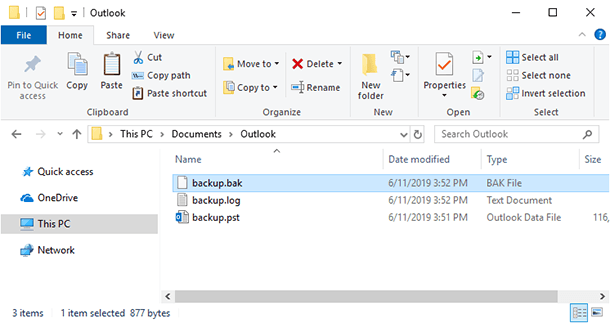
Outlook 2007 on Windows Vista/Windows 7 file locations
#Windows 7 outlook ost file location how to#
How to View Hidden Files and Folders For Windows Vista: Some of these files might be hidden, so you may need to turn on the option to show hidden files and folders before you can locate the files. Note that you probably will not find all of the files listed below in your configuration, because some of the files are not created until you customize Outlook features. This article lists all the possible Outlook files that you may want to include in your backups. You may also want to manually back up or export other Outlook files. pst files, which store everything for Outlook. Microsoft provides an Outlook add-in called Personal Folders Backup. You can use DataNumen Exchange Recovery to scan the oversized OST file and convert it into a PST file in Outlook 2003 format that has no 2GB file size limitation, or split it into several PST files smaller than 2GB if you don’t have Outlook 2003 or higher versions installed.It is important to back up email files on a regular basis. The OST file will get corrupt when it reaches or exceeds 2GB.

Microsoft Outlook 2002 and earlier versions use an old OST file format that has a file size limit of 2GB.
#Windows 7 outlook ost file location Offline#
When you have various problems with your mailbox or offline folders, for example, the Exchange server crashes or you cannot synchronize the offline updates with the server, we highly recommend you to use DataNumen Exchange Recovery to recover all data in it. The OST file is the local copy of your Exchange mailbox, which contains all your most important personal communication data and information, including emails, folders, posts, appointments, meeting requests, contacts, distribution lists, tasks, task requests, journals, notes, etc. You may also search for file “*.ost” in your local computer to find the location of the file. The offline folder (.ost) file, like Outlook personal folders (.pst) file, is normally located in a predefined folder.įor Windows 95, 98 and ME, the folder is:Ĭ:WindowsApplication DataMicrosoftOutlookĬ:WindowsProfilesuser nameLocal SettingsApplication DataMicrosoftOutlookįor Windows NT, 2000, XP and 2003 server, the folder is:Ĭ:Documents and Settingsuser nameLocal SettingsApplication DataMicrosoftOutlookĬ:Documents and Settingsuser nameApplication DataMicrosoftOutlookĬ:Usersuser nameAppDataLocalMicrosoftOutlookĬ:Useruser nameLocal SettingsApplication DataMicrosoftOutlookĬ:UsersusernameAppDataLocalMicrosoftOutlook At that time, you can utilize DataNumen Exchange Recovery to recover most of the contents in your Exchange mailbox by scanning and processing the data in local offline folder file.

Offline folders or Cached Exchange Mode has several advantages: It is featured in more efficient synchronization mechanisms and more convenient offline operations. Since Outlook 2003, Microsoft introduces a Cached Exchange Mode, which is actually an improved version of original offline folders. A log file will be used to record all the important information about the synchronization, for your reference later. You can select to synchronize only a specific folder, a group of folders, or all the folders. However, all these changes will not be reflected to your mailbox on the Exchange server until you connect to the network again and synchronize the offline folders with the server.ĭuring the synchronization process, Outlook will connect to the Exchange server via network, copy all the changes made so that the offline folders will be identical to the mailbox again. For example, you can send emails which are actually put in the offline Outbox, you can also receive new messages from the other online mailboxes, and you can make changes to the emails and other items as you want. When working offline, you can do everything with the offline folders just as if it were the mailbox on the server. OST is the abbreviation for “Offline Storage Table”. At that time, Outlook will make an exact copy of your mailbox on the Exchange Server, called offline folders, and store it in a local file, which is called offline folder file and has a. When Outlook is used in conjunction with Microsoft Exchange Server, you can set it to work with the Exchange mailbox offline.


 0 kommentar(er)
0 kommentar(er)
